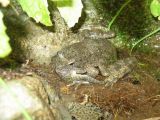Cannibalism can look odd by human standards, but in fact it's widespread in the animal kingdom, and also amongst many human populations in the past, and survived till the XX th century in some areas of Central Africa, South America, New Guinea and Vanuatu.
Because many infections pass from victims to consumers, diseases linked to cannibalism should be very common, fact that does not happen.
This could be due to the fact that cannibals usually feed alone. "Maybe this is why cannibalism is no longer common among people as it was in the past, because of the strong negative effects it can have when transmitting a disease," said ecologist Volker Rudolf at the University of Virginia at Charlottesville.
Cannibalism is "stunningly common in nature," Rudolf explained. "In the past, there were misconceptions that cannibalism was something that only happened in labs or under extreme conditions. But it isn't."
''It was quite a common practice in many human societies in the past," said Rudolf.
There are even proofs that Neanderthals could have practiced cannibalism.
There are diseases transmitted solely or mostly through cannibalism, like Kuru (see below), a deadly degenerative brain ailment in New Guinea, provoked by a prion like in the case of the mad cow disease, and is triggered only by the consume of human flesh.
Cannibalism is found from crustaceans and insects to mammals.
In spiders and praying mantis, the females normally eat the males during or after mating and in many fishes, frogs, salamanders, lizards, snakes and crocodiles the diet is mainly or partially composed by smaller individuals from the same species (it seems that cannibalism helps them colonize new environments where other prey species are scarce).
Rudolf's team found just two infections transmitted mostly through cannibalism: Kuru in humans, and the protozoan Sarcocystis in lizards, when they snack each others Tails.
Calculations led the researchers to the result that cannibalism was an effective vector if cannibals ate together rather than solo on the infected victims.
"Such group cannibalism is really rare in nature. Besides humans, the only other example we could find are with chimpanzees, where males group together to attack and consume other chimps. Cannibalism is very common in nature, but it's usually one-on-one," Rudolf said.
Other cases would be the young of certain insects and spiders known to devour their own mothers, while male lions are known to eat cubs after they acquire new harems.
In the case of nesting birds of prey, the flesh of the dead chickens is distributed by the parents between the surviving offspring.
In the hyenna and wolf packs, dead inviduals are usually eaten by the others.
Rudolf's team will investigate the effects inflicted by cannibalism in insects. "This is exciting work," said population ecologist Nat Holland at Rice University in Houston. "It raises the question of whether or not epidemics of sexually transmitted diseases in humans are related to the size of groups in orgies. Those are social diseases as well," he said.

 14 DAY TRIAL //
14 DAY TRIAL // 
